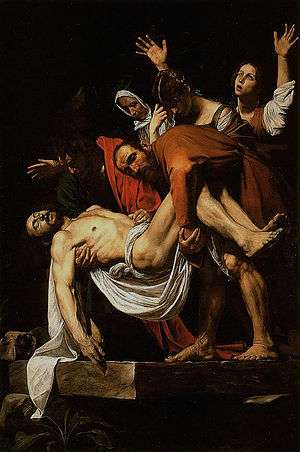Lost body hypothesis
The Lost body Hypothesis tries to explain the empty tomb of Jesus by a naturally occurring event, not by resurrection, fraud, theft or coma. Only the Gospel of Matthew (28:2) mentions a ‘great earthquake’ on resurrection day. The preceding crucifixion quake was accompanied by darkness, splitting of the rock and opening of graves (Matth. 27:51). In this way a crack in the rock can explain the empty tomb on resurrection day. The body of Jesus has fallen into a crevice produced by the earthquake and the crack closed again because of the aftershocks.[1]
| Part of a series on |
| Death and Resurrection of Jesus |
|---|
 |
|
|
Visions of Jesus
|
|
Empty tomb fringe theories |
|
Related |
|
Portals: |
- This is a sub-article of Death and resurrection of Jesus.
Matthew might be hinting at the earthquake events in verse 12:40: the Son of Man descending for three days in the heart of the earth, like Jonah was in the whale’s belly. The Gospels of Mark and Luke do not mention a quake, but only darkness at noon, splitting of the temple veil and the tombstone rolled away. John in his Gospel (12:24) and Paul in his Letters (1 Cor.15:36) used the image of a grain of wheat falling in the earth for the event of death and resurrection of Jesus.
18th century
According to the radical German rationalist and spiritualist Joh. Chr. Edelmann in his Confession of Faith (1746) the Matthean earthquake had buried the body and therefore it was lost. Edelmann combined his lost body hypothesis with a spiritual view on Jesus’ resurrection.
- “As to the last circumstance, which only Matthew mentions, I admit that the body of Lord Jesus in his grave could have been buried in such a way, that it could not have been found anywhere.”[2]
20th century
The Austrian spiritualist, R.J.L. Steiner, in his article, The Fifth Gospel (1913), described what his "clairvoyant consciousness" saw as an earthquake that hid the body of Jesus:
- “That earthquake shook the tomb in which Jesus' body lay – and the stone which had been placed before the tomb was ripped away and a crevice opened in the ground and the body fell onto the crevice. Further vibrations caused the ground to close over the crevice. And when the people came in the morning the tomb was empty, for the earth had received Jesus' body; the stone, however, remained apart from the tomb.”[3]
In 1925 the German theologist R. Seeberg seems to have entertained a lost body hypothesis as a possibility in his Christliche Dogmatik (Allison).
Historicity of the Matthean earthquake
The church father Origen has interpreted the Matthean earthquake as a historical but local, Judean phenomenon.[4] A widespread 6.3 magnitude earthquake has been confirmed to have taken place between 26-36 AD in the time of Jesus.[5] The authors concluded that:
Plausible candidates include the earthquake reported in the Gospel of Matthew, an earthquake that occurred sometime before or after the crucifixion and was in effect ‘borrowed’ by the author of the Gospel of Matthew, and a local earthquake between 26 and 36 AD that was sufficiently energetic to deform the sediments at Ein Gedi but not energetic enough to produce a still extant and extra-biblical historical record. If the last possibility is true,this would mean that the report of an earthquake in the Gospel of Matthew is a type of allegory.
See also
Notes
- Dale C. Allison, Resurrecting Jesus: The Earliest Christian Tradition And Its Interpreters (2005), p.204
- Joh. Chr. Edelmann, “Abgenöthigtes, jedoch Andern nicht wieder aufgenöthigtes Glaubens-Bekenntniß”, (1746), p.196, translation of the German text
- R. Steiner, The Fifth Gospel (Das Fünfte Evangelium, 1913)
- Dale C. Allison, “Studies in Matthew: Interpretation Past And Present”, (2005), p. 89
- Jefferson Williams, Markus Schwab and A. Brauer (2012). An early first-century earthquake in the Dead Sea. International Geology Review.full article